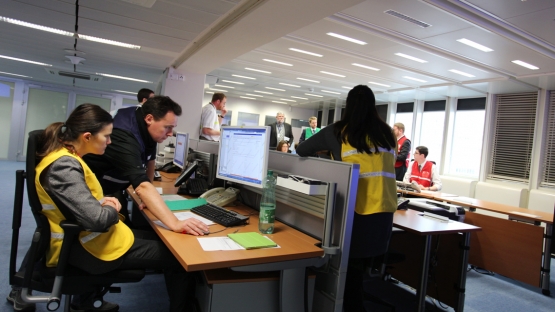A woman wearing a blue vest with the words Liaison Officer on its back picks up the phone and dials a number. “This is an exercise, this is an exercise,” she says in Spanish. “The IAEA has been informed by the Mexican authorities that a radioactive source from a hospital in the Northern Mexican city of Tijuana has been stolen. The latest information we have is that the source has been tracked in Terminal 1 of the Mexico City International Airport.”
Around her, others wearing different-coloured vests to distinguish the various responder roles work together to coordinate the key actions needed during an emergency situation. The room on the 9th floor of the IAEA is locked to outsiders, and is filled with computers, notes and phones. In the centre a wide screen shows messages changing constantly. This is how a real-time emergency exercise organized by the IAEA looks.
Last month, 53 countries were challenged to react to a simulated radiological emergency in Mexico, testing their capacity to respond. Emergency professionals communicated with national counterparts and international partners to find the best ways to respond together.
“Exercises like this are an opportunity for us to check our response arrangements. In the case of Mexico, this exercise was particularly useful to test lessons learned after 2013,” said Juan Eibenschutz, Director General of Mexico’s National Nuclear Security and Safeguards Commission (CNSNS).
In December 2013, a radioactive source was actually stolen from a truck and found by Mexican authorities in a field close by a few days later. The perpetrators were later found to have suffered radiation exposure. The IAEA emergency exercise evokes a very similar scenario.
In this scenario, a teletherapy machine containing a radioactive isotope used for treating cancer was robbed from a truck in Mexico, dismantled and broken. The unshielded source was eventually spotted in a backpack at the Mexico City International Airport.
The challenge for the professionals involved in the exercise was to mitigate the consequences with international support. Mexico, for example, sought for fictitious assistance from different countries in searching and recovering the source, conducting a radiation survey, and providing medical and decontamination services to the population.
“We organize these exercises to test how professionals cooperate at the international level, based on the international arrangements and the guidance of the IAEA,” said Elena Buglova, head of the IAEA’s Incident and Emergency Centre. Acting as a hub for notification and information exchange, the Centre assessed the emergency situation, provided regular updates for the participating countries and monitored all actions of the in-house players during the exercise. It also prepared information for the media.
Giving a hand
To ensure that countries know where to seek assistance in case of radiological and nuclear incidents or emergencies, the IAEA set up the IAEA Response and Assistance Network (RANET). At the moment, RANET contains details of qualified experts, equipment and materials available from 28 countries. In case of an emergency, any country can seek assistance and advice immediately through RANET.
Every year, the IAEA conducts exercises called Convention Exercises, or ConvEx, inviting countries to test their response arrangements to various types of incidents and emergencies. The IAEA also develops and prepares operational procedures to respond to incidents and emergencies and trains its staff.
In the event of a nuclear or radiological emergency, the IAEA has defined responsibilities and functions which are specified under the Convention on Early Notification of a Nuclear Accident (the Early Notification Convention) and the Convention on Assistance in the Case of a Nuclear Accident or Radiological Emergency (the Assistance Convention).
We organize these exercises to test how professionals cooperate at the international level, based on the international arrangements and the guidance of the IAEA.



